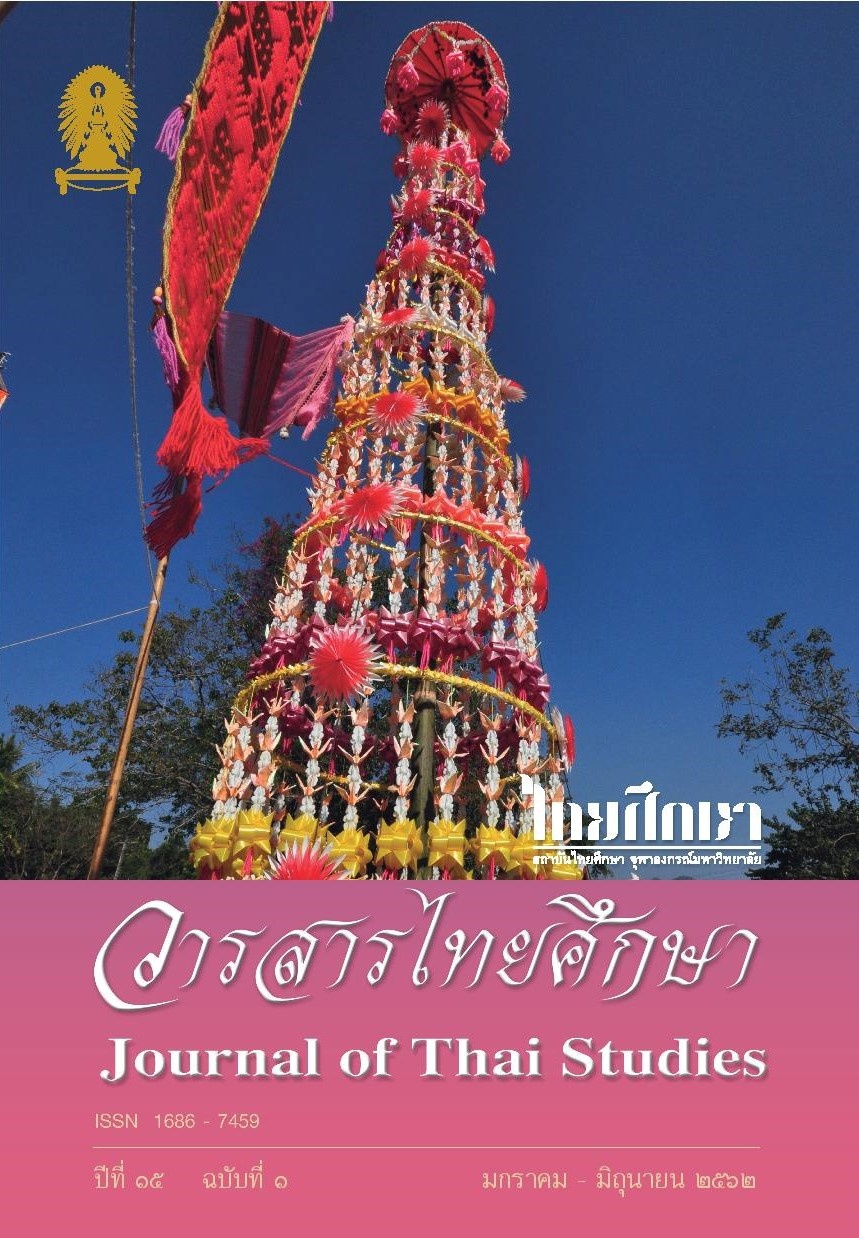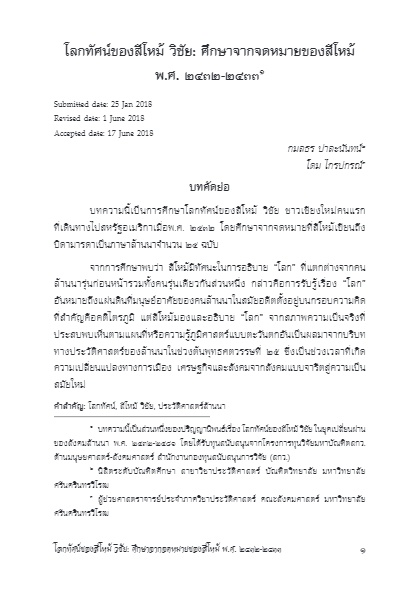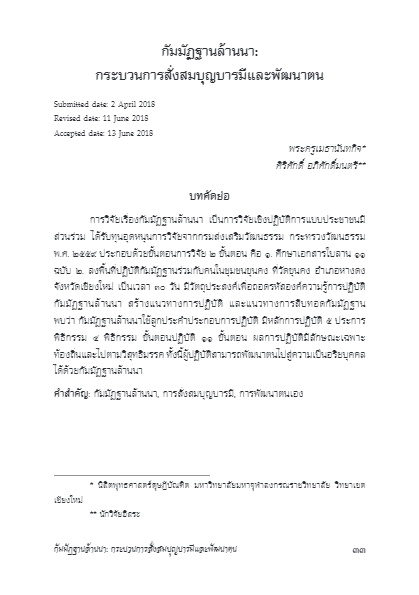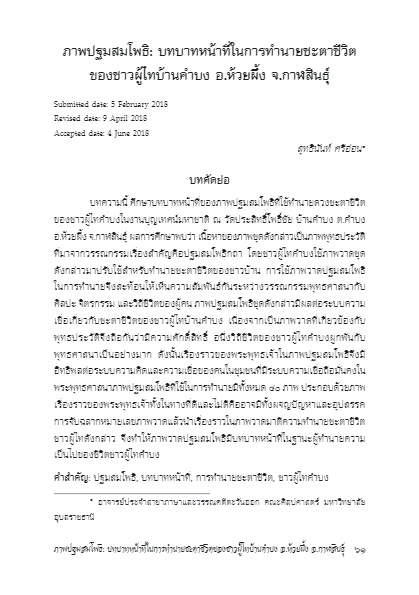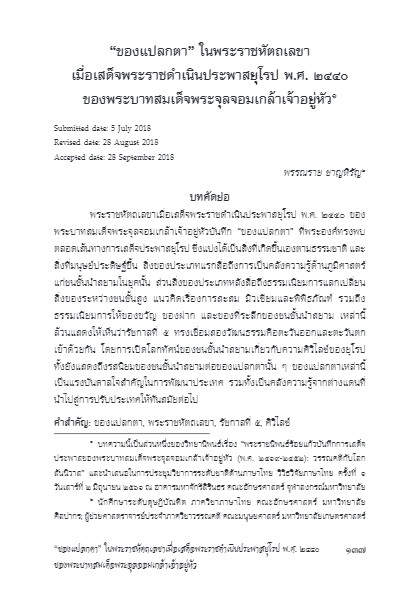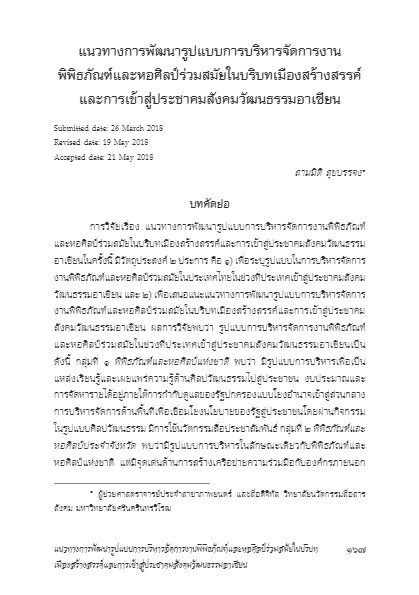วารสารไทยศึกษา - ปีที่ 15 ฉบับที่ 1
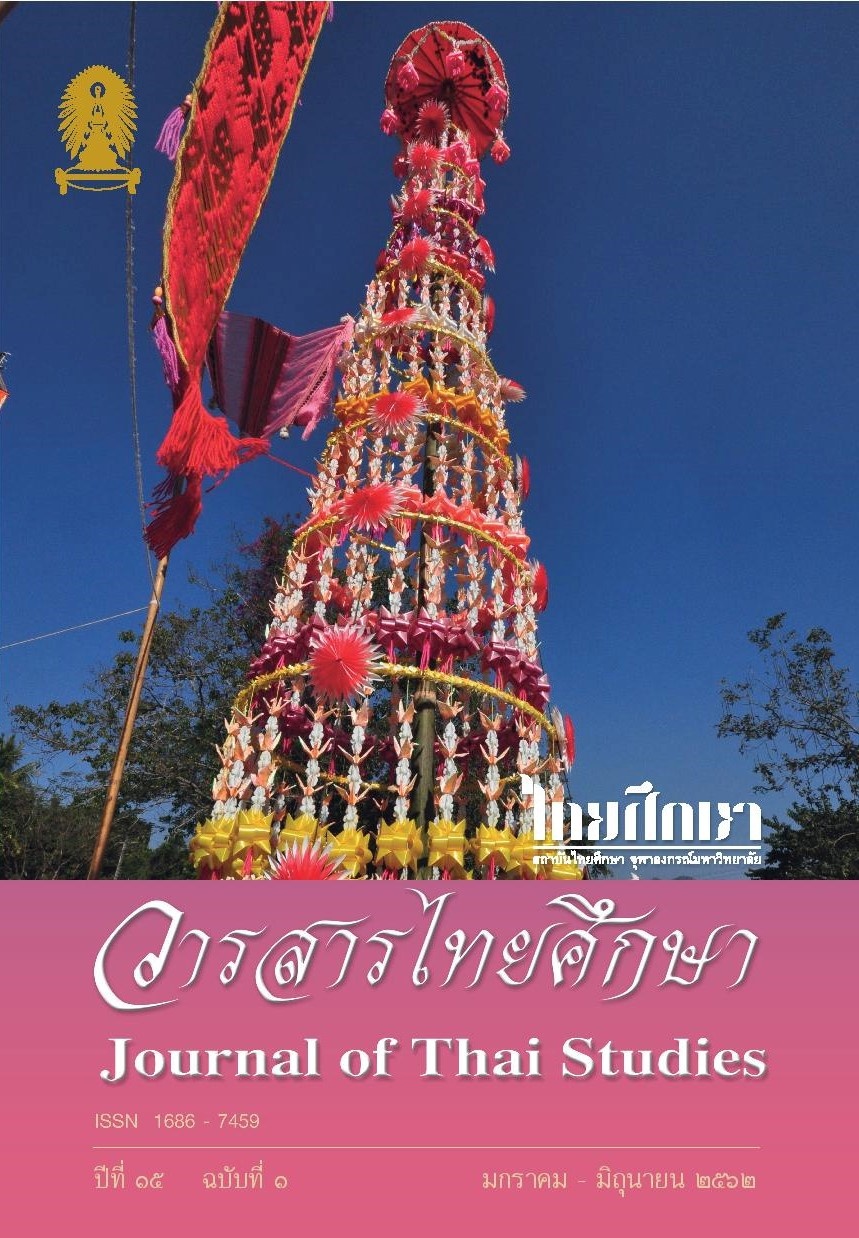
1)โลกทัศน์ของสีโหม้ วิชัย : ศึกษาจากจดหมายของสีโหม้ พ.ศ.2432-2433/ กมลธร ปาละนันทน์, โดม ไกรปกรณ์
2) กัมมัฏฐานล้านนา: กระบวนการสั่งสมบุญบารมีและพัฒนาตน/ พระครูเมธานันทกิจ, ศิริศักดิ์ อภิศักดิ์มนตรี
3) ภาพปฐมสมโพธิ: บทบาทหน้าที่ในการทำนายชะตาชีวิตของชาวผู้ไทบ้านคำบง อ.ห้วยผึ้ง จ.กาฬสินธุ์/ สุทธินันท์ ศรีอ่อน
4) บทละครเรื่อง เงาะป่า: จากข้อมูลคติชนสู่การสร้างสรรค์วรรณคดี/ ศรัณย์ภัทร บุญฮก
5) “ของแปลกตา” ในพระราชหัตถเลขาเมื่อเสด็จพระราชดำเนินประพาสยุโรป พ.ศ. 2440 ของพระบาทสมเด็จพระจุลจอมเกล้าเจ้าอยู่หัว/ พรรณราย ชาญหิรัญ
6) แนวทางการพัฒนารูปแบบการบริหารจัดการงานพิพิธภัณฑ์และหอศิลป์ร่วมสมัยในบริบทเมืองสร้างสรรค์และการเข้าสู่ประชาคมสังคมวัฒนธรรมอาเซียน/ สามมิติ สุขบรรจง
โลกทัศน์ของสีโหม้ วิชัย : ศึกษาจากจดหมายของสีโหม้ พ.ศ.2432-2433
กมลธร ปาละนันทน์
โดม ไกรปกรณ์
บทคัดย่อ
บทความนี้เป็นการศึกษาโลกทัศน์ ของสีโหม้ วิชัย ชาวเชียงใหม่คนแรกที่เดินทางไปสหรัฐอเมริกาเมื่อพ.ศ.2432 โดยศึกษาจากจดหมายที่สีโหม้เขียนถึงบิดามารดาเป็นภาษาล้านนาจำนวน 24 ฉบับ
จากการศึกษาพบว่า สีโหม้มีทัศนะในการอธิบาย “โลก” ที่แตกต่างจากคนล้านนารุ่นก่อนหน้ารวมทั้งคนรุ่นเดียวกันส่วนหนึ่ง กล่าวคือการรับรู้เรื่อง “โลก” อันหมายถึงแผ่นดินที่มนุษย์อาศัยของคนล้านนาในสมัยอดีตตั้งอยู่บนกรอบความคิดที่สำคัญคือคติไตรภูมิ แต่สีโหม้มองและอธิบาย “โลก” จากสภาพความเป็นจริงที่ประสบพบเห็นตามแผนที่หรือความรู้ภูมิศาสตร์แบบตะวันตกอันเป็นผลมาจากบริบททางประวัติศาสตร์ของล้านนาในช่วงต้นพุทธศตวรรษที่ ๒๕ ซึ่งเป็นช่วงเวลาที่เกิดความเปลี่ยนแปลงทางการเมือง เศรษฐกิจและสังคมจากสังคมแบบจารีตสู่ความเป็นสมัยใหม่
คำสำคัญ : โลกทัศน์, สีโหม้ วิชัย, ประวัติศาสตร์ล้านนา
(ตีพิมพ์ใน วารสารไทยศึกษา ปีที่ 15 ฉบับที่ 1 (มกราคม – มิถุนายน 2562) หน้า 1-32)
Simo Wichai’s Worldview: The Study of Simo’s Letters during 1889-1890
Kamoldhorn Palanandana
Dome Kraipakorn
Abstract
This article is a study of worldview of Simo Wichai, the first Chiangmai resident who traveled to the United States in 1889. The study was based on 24 letters, written by Simo to his parents in Lanna script.
According to study, Simo had the attitude towards "the world" different from the previous generation, as well as some of the same generation, of Chiang Mai native residents. In traditional society viewpoint at the period, the perception of “the world” which referred to the land of Lanna people was based on the influential concept of Trailokya – the Three Worlds. Simo, in contrary, viewed and described “the world” based on his realistic experience on modern maps and Western geographic knowledge which was a consequence of political, economic, and social change from conservative to modern society in Lanna’s historical context in the beginning of the 25th century of Buddhist era (late 19 century of Christian Era).
Keywords : Worldview, Simo Wichai, Lanna History
(Published in Journal of Thai Studies Volume 15 Number 1 (January – June 2019) Page 1-32)
บทความ / Full Text : Download
กัมมัฏฐานล้านนา: กระบวนการสั่งสมบุญบารมีและพัฒนาตน
พระครูเมธานันทกิจ
ศิริศักดิ์ อภิศักดิ์มนตรี
บทคัดย่อ
การวิจัยเรื่องกัมมัฏฐานล้านนา เป็นการวิจัยเชิงปฏิบัติการแบบประชาชนมีส่วนร่วม ได้รับทุนอุดหนุนการวิจัยจาก กรมส่งเสริมวัฒนธรรม กระทรวงวัฒนธรรม พ.ศ. 2559 ประกอบด้วยขั้นตอนการวิจัย 2 ขั้นตอน คือ 1. ศึกษาเอกสารใบลาน 11 ฉบับ 2. ลงพื้นที่ปฏิบัติกัมมัฏฐานร่วมกับคนในชุมชนขุนคง ที่วัดขุนคง อำเภอหางดง จังหวัดเชียงใหม่ เป็นเวลา 30 วัน มีวัตถุประสงค์เพื่อถอดรหัสองค์ความรู้การปฏิบัติกัมมัฏฐานล้านนา สร้างแนวทางการปฏิบัติ และแนวทางการสืบทอดกัมมัฏฐาน พบว่ากัมมัฏฐานล้านนาใช้ลูกประคำประกอบการปฏิบัติ มีหลักการปฏิบัติ 5 ประการ พิธีกรรม 1 พิธีกรรม ขั้นตอนปฏิบัติ 11 ขั้นตอน ผลการปฏิบัติมีลักษณะเฉพาะท้องถิ่นและไปตามวิสุทธิมรรค ทั้งนี้ผู้ปฏิบัติสามารถพัฒนาตนไปสู่ความเป็นอริยบุคคลได้ด้วยกัมมัฏฐานล้านนา
คำสำคัญ : กัมมัฏฐานล้านนา; การสั่งสมบุญบารมี; การพัฒนาตนเอง
(ตีพิมพ์ใน วารสารไทยศึกษา ปีที่ 15 ฉบับที่ 1 (มกราคม – มิถุนายน 2562) หน้า 33-59)
Kammaṭṭhāna Lanna: The Methods of Merit-Making and Self Development.
Phrakhru Metanantakit
Sirisak Apisakmontree
Abstract
This research on the ancient Lanna Kammaṭṭhāna is a community-based participatory action research project supported by a research grant from the Department of Cultural Promotion, Ministry of Culture. The research process involved two main procedures: 1) a study of 11 palm-leaf manuscripts and 2) participation in a 30 day practice of Lanna Kammaṭṭhāna with the residents of Khun Khong community at Wat Khun Khong temple in Hang Dong, Chiang Mai. The objective was to comprehend deeply the knowledge of Lanna Kammaṭṭhāna, while also establishing guidelines for performing and preserving this ancient practice. Evidently, Lanna Kammaṭṭhāna use beads in order to make merit and consists of five principles of conduct, four rituals and 11 steps of implementation. The results are unique to the locality and follow the Visuddhimagga. The practitioner can develop himself to attain enlightenment by Lanna Kammaṭṭhāna.
Keyword : Kammaṭṭhāna Lanna; Merit-Making; Self Development
(Published in Journal of Thai Studies Volume 15 Number 1 (January – June 2019) Page 33-59)
บทความ / Full Text : Download
ภาพปฐมสมโพธิ: บทบาทหน้าที่ในการทำนายชะตาชีวิตของชาวผู้ไทบ้านคำบง อ.ห้วยผึ้ง จ.กาฬสินธุ์
สุทธินันท์ ศรีอ่อน
บทคัดย่อ
บทความนี้ศึกษาบทบาทหน้าที่ของภาพปฐมสมโพธิที่ใช้ทำนายดวงชะตาชีวิตของชาวผู้ไทคำบงในงานบุญเทศน์มหาชาติ ณ วัดประสิทธิ์โพธิ์ชัย บ้านคำบง ต.คำบง อ.ห้วยผึ้ง จ.กาฬสินธุ์ ผลการศึกษาพบว่าเนื้อหาของภาพชุดดังกล่าวเป็นภาพพุทธประวัติที่มาจากวรรณกรรมเรื่องสำคัญคือปฐมสมโพธิกถา โดยชาวผู้ไทคำบงใช้ภาพวาดชุดดังกล่าวมาปรับใช้สำหรับทำนายชะตาชีวิตของชาวบ้าน การใช้ภาพวาดปฐมสมโพธิในการทำนายจึงสะท้อนให้เห็นความสัมพันธ์กันระหว่างวรรณกรรมพุทธศาสนากับศิลปะจิตรกรรมและวิถีชีวิตของผู้คน ภาพปฐมสมโพธิชุดดังกล่าวมีผลต่อระบบความเชื่อเกี่ยวกับชะตาชีวิตของชาวผู้ไทบ้านคำบง เนื่องจากเป็นภาพวาดที่เกี่ยวข้องกับพุทธประวัติจึงถือกันว่ามีความศักดิ์สิทธิ์ อนึ่งวิถีชีวิตของชาวผู้ไทคำบงผูกพันกับพุทธศาสนาเป็นอย่างมาก ดังนั้นเรื่องราวของพระพุทธเจ้าในภาพปฐมสมโพธิจึงมีอิทธิพลต่อระบบความคิดและความเชื่อของคนในชุมชนที่มีระบบความเชื่อถือมั่นคงในพระพุทธศาสนาภาพปฐมสมโพธิที่ใช้ในการทำนายมีทั้งหมด ๘๐ ภาพ ประกอบด้วยภาพเรื่องราวของพระพุทธเจ้าทั้งในทางที่ดีและไม่ดีคืออาจมีทั้งผจญปัญหาและอุปสรรค การจับฉลากหมายเลขภาพวาดแล้วนำเรื่องราวในภาพวาดมาตีความทำนายชะตาชีวิตชาวผู้ไทดังกล่าว จึงทำให้ภาพวาดปฐมสมโพธิมีบทบาทหน้าที่ในฐานะผู้ทำนายความเป็นไปของชีวิตชาวผู้ไทคำบง
คำสำคัญ: ปฐมสมโพธิ, บทบาทหน้าที่, การทำนายชะตาชีวิต, ชาวผู้ไทคำบง
(ตีพิมพ์ใน วารสารไทยศึกษา ปีที่ 15 ฉบับที่ 1 (มกราคม – มิถุนายน 2562) หน้า 61-103)
Pathomsombodhi Paintings: The Function for predicting the life of Phutai Ban Khambong people, Huai Phueng District,Kalasin Province
Sudhinan Sri-on
Abstract
The purpose of this article was to study the fortune-telling function of the Pathomsombodhi paintings in Prasitbochai Temple, Bankhmbong Khambong Sub-district, Huayphueng District, Kalasin Province, during the Phutai’s Vessantara chanting ceremony. The study found that the contents of the paintings were related to the stories about the Buddha in Pathomsombodhi literature. The Phuthai Khambong people have constructed a new meaning and a new function to these paintings by using them as a tool for fortune-telling. The use of the paintings of the Buddha’s stories to predict people’s life reflects the relationship among Buddhist literature, art and people’s ways of life. The Pathomsombodhi paintings affected the belief about the future life of the Phuthai Khambong people because the paintings contained the Buddha’s stories, which are believed to be highly scared. Moreover, as the ways of life of the Phuthai Khambong people are highly connected with Buddhism, the Buddha’s stories in the Pathomsombodhi paintings strongly influence the system of thinking and belief of the Phuthai Khambong people. The Buddha’s stories in the Pathomsombodhi paintings included various positive and negative stories about the Buddha. When a person picks up a number to select a painting, the story in the selected painting can be used to interpret and predict the future of that person. Thus the Pathomsombodhi paintings have taken on the function as a fortune teller, forecasting the people’s life.
Keywords: Pathomsombodhi, Function, predicting the life, Phutai Khambong People.
(Published in Journal of Thai Studies Volume 15 Number 1 (January – June 2019) Page 61-103)
บทความ / Full Text : Download
บทละครเรื่อง เงาะป่า: จากข้อมูลคติชนสู่การสร้างสรรค์วรรณคดี
ศรัณย์ภัทร์ บุญฮก
บทคัดย่อ
บทความนี้มุ่งศึกษาลักษณะข้อมูลคติชนที่ปรากฏและวิเคราะห์กลวิธีการนำข้อมูลคติชนมาสร้างเป็นวรรณคดีในบทละครเรื่องเงาะป่า พระราชนิพนธ์ในพระบาทสมเด็จพระจุลจอมเกล้าเจ้าอยู่หัว ผลการศึกษาพบว่า เงาะป่า รวบรวมข้อมูลคติชนของชาวก็อยไว้หลายด้านผ่านบทความขนาดสั้นตอนต้นบทละคร ก่อนที่ข้อมูลดังกล่าวจะถูกนำเสนอสอดแทรกเป็นองค์ประกอบต่างๆ ในเรื่องราวอย่างแนบเนียน ข้อมูลคติชนของชาวก็อยดังกล่าวนับว่าสัมพันธ์กับองค์ประกอบทางวรรณคดีทุกส่วน ทั้งการผูกปมขัดแย้งหลักที่เกิดจากประเพณีเกี่ยวกับการมีคู่ครองของก็อย ข้อมูลคติชนอย่างเครื่องแต่งกาย อาวุธ ความเป็นอยู่ตลอดจนความคิดที่กล่าวไว้ตอนต้นมานำเสนอผ่านตัวละคร การทำให้ฉากป่ามีสีสันของท้องถิ่น ที่สำคัญคือ การนำเสนอฉากแต่งงานที่นับว่าได้ประมวลคติชนของชาวก็อยแทบทุกด้านไว้ องค์ประกอบต่างๆ ได้นำไปสู่แนวคิดเรื่องความรักที่ยิ่งใหญ่ของตัวละครเอกซึ่งเป็นแนวคิดสากลให้เห็นว่าคนกลุ่มนี้มีความเป็นมนุษย์ไม่ต่างจากคนกลุ่มอื่น ส่วนในแง่การแสดง สถานภาพของชาวก็อยทำให้บทละครมีรูปแบบและเนื้อหาแปลกใหม่ไปจากละครไทยดั้งเดิม การบรรจุเพลงและเครื่องแต่งกายก็มีลักษณะเปลี่ยนแปลงไปให้สอดคล้องกับชาวก็อย จึงกล่าวได้ว่า ข้อมูลคติชนนับเป็นองค์ประกอบสำคัญต่อการสร้างสรรค์วรรณคดีเรื่องนี้บนพื้นฐานความสมจริง
คำสำคัญ: เงาะป่า, พระบาทสมเด็จพระจุลจอมเกล้าเจ้าอยู่หัว, ข้อมูลคติชน
(ตีพิมพ์ใน วารสารไทยศึกษา ปีที่ 15 ฉบับที่ 1 (มกราคม – มิถุนายน 2562) หน้า 105-135)
The Play “Ngo Pa”: From Folklore to Literature
Saranpat Bookhok
Abstract
The article aims at exploring information regarding folklore and at analyzing the application of folklore in “Ngo Pa,” a play composed by King Chulalongkorn (King Rama V). It was found that information on various aspects of Koy people and their beliefs is portrayed throughout the play Ngo Pa, particularly in a short prelude at the beginning of the play. It is evident that information was deliberately asserted in various parts of the play. Furthermore, Koy people’s folklore is shown in relation to every literature element, including the main conflict caused by Koy’s belief in married life. Koy people’s folklore regarding clothes, weapons, lifestyles and beliefs mentioned in the first part of the play is also reflected through characters and forest setting with the vivid hint of the locals. It cannot be denied that the most important scene is the marriage scene, which conveys every aspect of Koy people’s folklore. These elements lead to the theme of powerful love between the main characters, an international theme highlighting the fact that these people are humans just like other groups of people. Regarding performance, Koy people’s status results in new and different patterns and content compared to traditional Thai plays. Music and clothing are furthermore adapted to correspond with the portrayal of the Koy people. In conclusion, information regarding folklore is considered important for this literature based on facts.
Keywords: Ngo Pa, King Chulalongkorn (Rama V), Folklore
(Published in Journal of Thai Studies Volume 15 Number 1 (January – June 2019) Page 105-135)
บทความ / Full Text : 4_Saranpat.pdf
“ของแปลกตา” ในพระราชหัตถเลขา เมื่อเสด็จพระราชดำเนินประพาสยุโรป พ.ศ. 2440 ของพระบาทสมเด็จพระจุลจอมเกล้าเจ้าอยู่หัว
พรรณราย ชาญหิรัญ
บทคัดย่อ
พระราชหัตถเลขาเมื่อเสด็จพระราชดำเนินประพาสยุโรป พ.ศ. 2440 ของพระบาทสมเด็จพระจุลจอมเกล้าเจ้าอยู่หัวบันทึก “ของแปลกตา” ที่พระองค์ทรงพบตลอดเส้นทางการเสด็จประพาสยุโรป ซึ่งแบ่งได้เป็นสิ่งที่เกิดขึ้นเองตามธรรมชาติ และสิ่งที่มนุษย์ประดิษฐ์ขึ้น สิ่งของประเภทแรกสื่อถึงการเป็นคลังความรู้ด้านภูมิศาสตร์แก่ชนชั้นนำสยามในยุคนั้น ส่วนสิ่งของประเภทหลังสื่อถึงธรรมเนียมการแลกเปลี่ยนสิ่งของระหว่างชนชั้นสูง แนวคิดเรื่องการสะสม มิวเซียมและพิพิธภัณฑ์ รวมถึงธรรมเนียมการให้ของขวัญ ของฝาก และของที่ระลึกของชนชั้นนำสยาม เหล่านี้ล้วนแสดงให้เห็นว่ารัชกาลที่ ๕ ทรงเชื่อมสองวัฒนธรรมคือตะวันออกและตะวันตกเข้าด้วยกัน โดยการเปิดโลกทัศน์ของชนชั้นนำสยามเกี่ยวกับความศิวิไลซ์ของยุโรป ทั้งยังแสดงถึงรสนิยมของชนชั้นนำสยามต่อของแปลกตานั้นๆ ของแปลกตาเหล่านี้เป็นแรงบันดาลใจสำคัญในการพัฒนาประเทศ รวมทั้งเป็นคลังความรู้จากต่างแดนที่นำไปสู่การปรับประเทศให้ทันสมัยต่อไป
คำสำคัญ: ของแปลกตา; พระราชหัตถเลขา; รัชกาลที่ 5; ศิวิไลซ์
(ตีพิมพ์ใน วารสารไทยศึกษา ปีที่ 15 ฉบับที่ 1 (มกราคม – มิถุนายน 2562) หน้า 137-166)
Exotic Objects” in King Chulalongkorn’s Royal Letters from Europe in 1897
Phannarai Chanhiran
Abstract
King Chulalongkorn’s royal letters sent from Europe in 1897 record “exotic objects” the King encountered during his trip. The objects can be divided into 1) natural objects and 2) man-made objects. The natural objects became geographical knowledge for Siamese elites. The man-made objects represented gift exchanges, concepts of collecting and museums, and concepts of giving gifts and souvenirs. The significance of the description of the exotic objects was to bridge the cultures of the East and the West. To show Siamese elites taste and expand the worldviews of Siamese elites, the king shared his experiences in Europe under the name of “being civilized”. Exotic objects were an important inspiration and knowledge regarding foreign countries for the modernization of Siam.
Keywords: exotic objects; royal letters; King Chulalongkorn; being civilized
(Published in Journal of Thai Studies Volume 15 Number 1 (January – June 2019) Page 137-166)
บทความ / Full Text : Download
แนวทางการพัฒนารูปแบบการบริหารจัดการงานพิพิธภัณฑ์และหอศิลป์ร่วมสมัยในบริบทเมืองสร้างสรรค์และการเข้าสู่ประชาคมสังคมวัฒนธรรมอาเซียน
สามมิติ สุขบรรจง
บทคัดย่อ
การวิจัยเรื่อง แนวทางการพัฒนารูปแบบการบริหารจัดการงานพิพิธภัณฑ์และหอศิลป์ร่วมสมัยในบริบทเมืองสร้างสรรค์และการเข้าสู่ประชาคมสังคมวัฒนธรรมอาเซียนในครั้งนี้ มีวัตถุประสงค์ 2 ประการ คือ 1) เพื่อระบุรูปแบบในการบริหารจัดการงานพิพิธภัณฑ์และหอศิลป์ร่วมสมัยในประเทศไทยในช่วงที่ประเทศเข้าสู่ประชาคมสังคมวัฒนธรรมอาเซียน และ 2) เพื่อเสนอแนะแนวทางการพัฒนารูปแบบการบริหารจัดการงานพิพิธภัณฑ์และหอศิลป์ร่วมสมัยในบริบทเมืองสร้างสรรค์และการเข้าสู่ประชาคมสังคมวัฒนธรรมอาเซียน ผลการวิจัยพบว่า รูปแบบการบริหารจัดการงานพิพิธภัณฑ์และหอศิลป์ร่วมสมัยในในช่วงที่ประเทศเข้าสู่ประชาคมสังคมวัฒนธรรมอาเซียนเป็นดังนี้ กลุ่มที่ 1 พิพิธภัณฑ์และหอศิลป์แห่งชาติ พบว่า มีรูปแบบการบริหารเพื่อเป็นแหล่งเรียนรู้และเผยแพร่ความรู้ด้านศิลปวัฒนธรรมไปสู่ประชาชน งบประมาณและการจัดหารายได้อยู่ภายใต้การกำกับดูแลของรัฐ ปกครองแบบโยงอำนาจเข้าสู่ส่วนกลาง การบริหารจัดการด้านพื้นที่เพื่อ เชื่อมโยงนโยบายของรัฐสู่ประชาชนโดยผ่านกิจกรรมในรูปแบบศิลปวัฒนธรรม มีการใช้นวัตกรรมสื่อประชาสัมพันธ์ กลุ่มที่ 2 พิพิธภัณฑ์และหอศิลป์ประจําจังหวัด พบว่ามีรูปแบบการบริหารในลักษณะเดียวกับพิพิธภัณฑ์และหอศิลป์แห่งชาติ แต่มีจุดเด่นด้านการสร้างเครือข่ายความร่วมมือกับองค์กรภายนอกในจังหวัดและข้ามจังหวัด มีการใช้สื่อท้องถิ่น และมีการพัฒนาสื่อประชาสัมพันธ์ รวมทั้งเน้นการจัดกิจกรรมที่เชื่อมโยงกับนโยบายของจังหวัด กลุ่มที่ 3 พิพิธภัณฑ์และหอศิลป์ในมหาวิทยาลัย พบว่ามีรูปแบบการบริหารที่รับนโยบายจากส่วนกลาง แต่มีลักษณะเด่นคือการสร้างเครือข่ายความสัมพันธ์ และบริหารจัดการเพื่อให้เป็นแหล่งเรียนรู้ที่สนับสนุนพันธกิจด้านการศึกษา รวมทั้งมีสถานะเป็นที่พึ่งให้กับศิลปิน นักวิชาการ และประชาชน กลุ่มที่ 4 พิพิธภัณฑ์และหอศิลป์เอกชน พบว่าแต่ละพิพิธภัณฑ์และหอศิลป์มีรูปแบบการบริหารจัดการที่หลากหลาย มีความคล่องตัวและยืดหยุ่นสูง บุคลากรมักทำงานได้หลายหน้าที่ มีการสร้างเครือข่ายกับองค์กรภายนอก การบริหารจัดการด้านพื้นที่มีการสร้างจุดเด่นในแต่ละพื้นที่ ผลการวิจัยประเด็นที่ 2 สรุปได้ดังนี้ แนวทางการพัฒนารูปแบบการบริหารจัดการงานพิพิธภัณฑ์และหอศิลป์ร่วมสมัยในบริบทเมืองสร้างสรรค์และการเข้าสู่ประชาคมสังคมวัฒนธรรมอาเซียนเป็นดังนี้ กลุ่มที่ 1 พิพิธภัณฑ์และหอศิลป์แห่งชาติ พบว่า มีการนำนโยบายฯ มาปรับใช้ในการกำหนดแนวทางการบริหารจัดการ กลุ่มที่ 2 พิพิธภัณฑ์และหอศิลป์ประจําจังหวัด พบว่ามีการนำนโยบายฯ มาปรับใช้ในการกำหนดแนวทางการบริหารจัดการ และมีการวางแผนให้ความรู้และสร้างความเข้าใจเรื่องอาเซียนในระดับบุคลากร แต่ยังไม่ปรากฏแผนการบริหารจัดการเพื่อให้เกิดความต่อเนื่อง กลุ่มที่ 3 พิพิธภัณฑ์และหอศิลป์ในมหาวิทยาลัย พบว่ามีการนำนโยบายฯ มาปรับใช้ในการกำหนดแนวทางการบริหารจัดการ แต่การให้ความสำคัญจะขึ้นอยู่กับผู้บริหารของแต่ละองค์กร กลุ่มที่ 4 พิพิธภัณฑ์และหอศิลป์เอกชน พบว่าส่วนใหญ่มิได้ให้ความสำคัญกับนโยบายฯ ว่าเป็นเรื่องเร่งด่วน เนื่องจากได้ดำเนินการเรื่องดังกล่าวมาก่อนหน้าที่รัฐบาลจะกำหนดนโยบาย และเสนอแนวทางการบริหารจัดการเพื่อให้เกิดความยั่งยืนว่า สิ่งที่จะทำให้ศิลปะของไทยสามารถตามเพื่อนบ้านอย่างอาเซียนทันคือการปรับตัวและการปลูกฝังความคิดเรื่องความคิดสร้างสรรค์ในระบบการศึกษา รวมทั้งการทำความเข้าใจกับวัฒนธรรมที่แตกต่างหลากหลายในภูมิภาคอาเซียนจะทำให้เกิดการแลกเปลี่ยนและทำให้วงการศิลปะร่วมสมัยยังดำรงอยู่ต่อไปได้
คำสำคัญ: พิพิธภัณฑ์, หอศิลป์ร่วมสมัย, การจัดการ, เมืองสร้างสรรค์, อาเซียน
(ตีพิมพ์ใน วารสารไทยศึกษา ปีที่ 15 ฉบับที่ 1 (มกราคม – มิถุนายน 2562) หน้า 167-204)
The Development Model for Museum and Contemporary Arts Gallery Management in the Context of the Creative City and the ASEAN Socio-Cultural Community-ASCC
Sammitt Sukbanjong
Abstract
The development model for museum and contemporary art gallery management in the context of the Creative City and the ASEAN Socio-Cultural Community-ASCC has two purposes. Firstly, to specify the style of management of contemporary museums and galleries in Thailand during the period of entry into the ASEAN Socio-Cultural Community-ASCC. Secondly, to provide guidance on the development of contemporary art museum and gallery management in the context of creative cities and the entry into the ASEAN Socio-Cultural Community-ASCC.
The results of the first objective of this research is to specify the style of management of contemporary museums and galleries in Thailand during the period of entry into the ASEAN Socio-Cultural Community-ASCC. Group 1: National museums and galleries were found to have an administrative model for learning and disseminating cultural knowledge to the people; budget and revenue provisions are subject to state oversight; space management links public policy to the people through cultural and artistic activities; the use of innovative media outlets. Group 2: Provencal museums and galleries were found to have an administrative style similar to that of the group of the national museums and galleries, with a strong network of cooperation with outside organizations in the province and across provinces; local media is used for the media development; the focus of activities is linked to the policy of the province. Group 3: For university museums and galleries, it was found that there is a centralized administration model, however a distinctive feature is the networking of relationships and managed to be a learning resource that supports the educational mission, as well as being a place for artists, academics and the public. Group 4: For private museums and galleries, each museum and gallery exhibits a variety of management styles and flexibility; personnel often perform multiple functions; networking with external organizations and space management has been featured in each area.
The results of the second objective of this research is to provide guidance on the development of contemporary art museum and gallery management in the context of creative cities and the entry into the ASEAN Socio-Cultural Community-ASCC. The results are as follows. Group 1: For national museums and galleries, it was found that they have implemented the policies to their management approach. Group 2: For provincial museums and galleries, it was found that they also have implement the policies to their management approach, which is a plan to educate and understand ASEAN Socio-Cultural Community-ASCC at the personnel level; management plans for continuity has not yet appeared. Group 3: For university museums and galleries, it was found that they have also implement the policies to their management approach; however, the importance depends on the management of each organization. Group 4: For private museums and galleries, it was found that most do not pay attention to the policies; which is an urgent matter because of their concern of these policies before the government has set and promoted the policies; private museums and galleries also propose a management approach for sustainability.
What will make the Thai art world follow the neighboring ASEAN is to adapt and implant ideas of creativity in the education system. Understanding the diversity of cultures in the ASEAN region will lead to exchanges and furtherance of contemporary art.
Keywords: museums, contemporary art galleries, management, Creative City, ASEAN
(Published in Journal of Thai Studies Volume 15 Number 1 (January – June 2019) Page 167-204)
บทความ / Full Text : download
